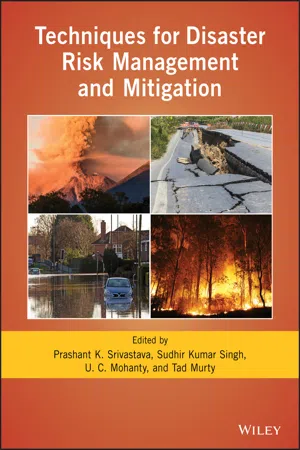
eBook - ePub
Techniques for Disaster Risk Management and Mitigation
This is a test
- English
- ePUB (mobile friendly)
- Available on iOS & Android
eBook - ePub
Techniques for Disaster Risk Management and Mitigation
Book details
Book preview
Table of contents
Citations
About This Book
A comprehensive guide to managing and mitigating natural disasters
Recent years have seen a surge in the number, frequency, and severity of natural disasters, with further increases expected as the climate continues to change. However, advanced computational and geospatial technologies have enabled the development of sophisticated early warning systems and techniques to predict, manage, and mitigate disasters. Techniques for Disaster Risk Management and Mitigation explores different approaches to forecasting disasters and provides guidance on mitigation and adaptation strategies.
Volume highlights include:
- Review of current and emerging technologies for disaster prediction
- Different approaches to risk management and mitigation
- Strategies for implementing disaster plans and infrastructure improvements
- Guidance on integrating artificial intelligence with GIS and earth observation data
- Examination of the regional and global impacts of disasters under climate variability
Frequently asked questions
At the moment all of our mobile-responsive ePub books are available to download via the app. Most of our PDFs are also available to download and we're working on making the final remaining ones downloadable now. Learn more here.
Both plans give you full access to the library and all of Perlego’s features. The only differences are the price and subscription period: With the annual plan you’ll save around 30% compared to 12 months on the monthly plan.
We are an online textbook subscription service, where you can get access to an entire online library for less than the price of a single book per month. With over 1 million books across 1000+ topics, we’ve got you covered! Learn more here.
Look out for the read-aloud symbol on your next book to see if you can listen to it. The read-aloud tool reads text aloud for you, highlighting the text as it is being read. You can pause it, speed it up and slow it down. Learn more here.
Yes, you can access Techniques for Disaster Risk Management and Mitigation by Prashant K. Srivastava, Sudhir Kumar Singh, U. C. Mohanty, Tad Murty, Prashant K. Srivastava, Sudhir Kumar Singh, U. C. Mohanty, Tad Murty in PDF and/or ePUB format, as well as other popular books in Scienze fisiche & Geologia e scienze della terra. We have over one million books available in our catalogue for you to explore.
Information
Section III
Land Hazards and Disasters
10
Satellite Radar Interferometry Processing and Elevation Change Analysis for Geoenvironmental Hazard Assessment
Sergey Stankevich1, Iryna Piestova1, Anna Kozlova1, Olga Titarenko1, and Sudhir Kumar Singh2
1 Scientific Centre for Aerospace Research of the Earth, National Academy of Sciences of Ukraine, Kiev, Ukraine
2 K. Banerjee Centre of Atmospheric and Ocean Studies, University of Allahabad, Allahabad, India
ABSTRACT
The technique for potentially hazardous land surface displacement mapping using satellite radar interferometry processing and elevation change analysis is presented. The primary data source is Sentinel‐1 satellite synthetic aperture radar (SAR) imagery. The high‐precision measured locations of ground control points (GCP) are used for land surface displacement accuracy improvement. The developed technique was used for elevation change analysis within the Kryvyi Rih (Ukraine) urban area. This region is characterized by a high degree of geoenvironmental hazard. The final map of geoenvironmental hazard within the study area is provided as output of satellite radar interferometry data analysis.
10.1. INTRODUCTION
Human activity leads to an anthropogenic impact on the natural landscape. Building industrial and energy potential, concentration of population in urban areas, and environmental pollution is a challenge to natural and social systems. The frequency and scope of human‐made and natural disasters significantly increased during the last few years. Environmental hazard maps delivering on demand are an urgent necessity now. This emphasizes the relevance of methods of development for geoenvironmental condition assessment to forecast, prevent, or mitigate the aftermath of disasters (Alcántara‐Ayala & Goudie, 2010). Such problems are really important within the industrial regions of Ukraine. The Kryvyi Rih urban area is a typical one.
10.2. STUDY AREA
Kryvyi Rih is the center of the Kryvorizkyi Iron Ore Basin (Kryvbas). This is the most important source of raw materials for metallurgy in Ukraine. A powerful industrial area around the city was formed as the result of the development of the Kryvbas deposits. The Kryvyi Rih industrial agglomeration lies from north to south along the Saksagan and Ingulets Rivers up to 120 km in length. The population of Kryvyi Rih city is about 650,000. The population reaches a million people with the Kryvyi Rih agglomeration.
The Kryvyi Rih industrial region plays a leading role in the economy of Ukraine. It has a strategic significance for economic independence and security of the state. Vigorous technogenic activity been undertaken for many years within the Kryvyi Rih urban area. Minerals are mined by the open‐pit method and the number of operating mines has increased. More than 35,000 hectares of land were disturbed due to mining processing. A powerful anthropogenic impact on the geological environment can be observed within the 585 km2 area of the Kryvyi Rih basin. This circumstance leads to changes in the regional landscape as well as in geological and hydrogeological conditions, namely:
- Deep opencast mines occupy almost 40 km2, from which about 14 billion cubic meters of ore and rocks have been seiz...
Table of contents
- Cover
- Table of Contents
- CONTRIBUTORS
- PREFACE
- Section I: Introduction
- Section II: Atmospheric Hazards and Disasters
- Section III: Land Hazards and Disasters
- Section IV: Ocean Hazards and Disasters
- INDEX
- End User License Agreement